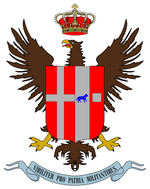This is an old revision of this page, as edited by Noclador (talk | contribs) at 22:06, 17 December 2024 (new article - part 1). The present address (URL) is a permanent link to this revision, which may differ significantly from the current revision.
Revision as of 22:06, 17 December 2024 by Noclador (talk | contribs) (new article - part 1)(diff) ← Previous revision | Latest revision (diff) | Newer revision → (diff) Inactive Italian Army cavalry unit| Regiment "Cavalleggeri di Piacenza" (18th) | |
|---|---|
| Reggimento "Cavalleggeri di Piacenza" (18°) | |
 Regimental coat of arms Regimental coat of arms | |
| Active | 28 Sept. 1859 — 21 Nov. 1919 |
| Country | |
| Branch | Royal Italian Army |
| Garrison/HQ | Caserta |
| Motto(s) | "Viriliter pro patria militantibus" |
| Anniversaries | 28 September 1859 - Anniversary of the regiment's formation |
| Insignia | |
| Regimental gorget patches | |
The Regiment "Cavalleggeri di Piacenza" (18th) (Italian: Reggimento "Cavalleggeri di Piacenza" (18°) - "Chevau-légers of Piacenza") is an inactive cavalry unit of the Royal Italian Army named for the city of Piacenza in the Emilia-Romagna. In September 1859, shortly after the Second Italian War of Independence, the Regiment Hussars of Piacenza was formed in Parma. The regiment's initial cadre consisted of a core of Hungarian exiles and Emilian volunteers. In 1860, the regiment was incorporated into the Royal Sardinian Army, as the army's only hussar regiment, and was allowed to retain its green and red colored uniform. In 1866, the regiment fought in the Third Italian War of Independence. In World War I the regiment fought on the Italian front. After the war the regiment was disbanded and its traditions assigned to the Regiment "Cavalleggeri di Novara". The regiment's anniversary falls on 28 September 1859, the day the regiment was formed.
History
Second Italian War of Independence

On 21 July 1858, French Emperor Napoleon III and the Prime Minister of Sardinia Camillo Benso, Count of Cavour met in Plombières and reached a secret verbal agreement on a military alliance between the French Empire and the Kingdom of Sardinia against the Austrian Empire. On 26 January 1859, Napoleon III signed the Franco-Sardinian Treaty, followed by King Victor Emmanuel II on 29 January 1859. On 9 March 1859, Sardinia mobilized its army, followed by Austria on 9 April. On 23 April, Austria delivered an ultimatum to Sardinia demanding its demobilization. Upon Sardinia's refusal, Austria declared war on 26 April and three days later the Austrians crossed the Ticino river into Piedmont. Consequently, France honored its alliance with Sardinia and declared war on Austria on 3 May 1859.
After the outbreak of the war, Princess Louise d'Artois, who ruled the Duchy of Parma and Piacenza as regent in the name of her young son Duke Robert I, fled Parma with her family and took refuge in the Austrian fortress at Mantua. A first revolutionary government in Parma was opposed by the dukedom's military and therefore Princess Louise returned for a short time, but after Austria lost the Battle of Magenta on 4 June 1859, Princess Louise left Parma again on 9 June. Shortly thereafter, the Sardinian Hunters of the Magra Corps occupied Parma. On 12 July 1859, the Second Italian War of Independence ended with the Armistice of Villafranca, which called for the rulers of the Grand Duchy of Tuscany, the Duchy of Modena and Reggio, and the Duchy of Parma and Piacenza, which all had fled their nations, to be restored to their thrones. However neither Sardinia nor the Sardinian installed governments in the three nations wished for a return of the rulers.
After the Armistice of Villafranca, around 20 Hungarian exiles, who had fought in the war on the Italian side, occupied the Palazzo della Pilotta in the center of Parma. The Hungarians were led by Count Gergely Bethlen, who had commanded the Hungarian 15th Hussar Regiment "King Matthias" during the 1848-49 Hungarian uprising.
References
- ^ F. dell'Uomo, R. Di Rosa (1998). L'Esercito Italiano verso il 2000 - Vol. Secondo - Tomo II. Rome: SME - Ufficio Storico. p. 43-44.
- "Le Feste dei Reparti - Settembre". Italian Army. Retrieved 17 December 2024.
- ^ Annuario militare del regno d'Italia - Volume I. Rome: Enrico Voghera. 1909. p. 510.
- ^ Brignoli, Marziano (2007). Cavalleria a Voghera. Voghera: Comune di Voghera. pp. 23–26.
- ^ Malipiero, Antonio (1973). Caricat!. Bologna: Casa Editrice Capitol. pp. 141–142.
| |||||||
| |||||||